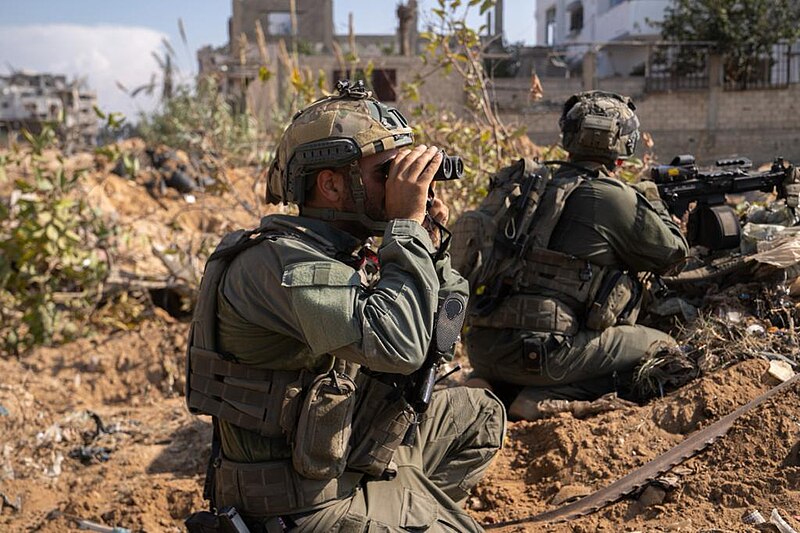
IDF troops inside the Gaza Strip > IDF Spokesperson’s Unit, CC BY-SA 3.0 DEED, via Wikimedia Commons.
Situation in Gaza
- Medications were provided to Israeli hostages on Wednesday 16 January, reportedly in return for an increase in the supply of pharmaceutical aid entering Gaza, following an agreement brokered by Qatar and France. Some 136 hostages remain captive in Gaza. Meanwhile events have been held in Israel and internationally to mark the first birthday of the youngest hostage in Gaza, Kfir Bibas, who was abducted with his mother and brother on October 7. Though Hamas told his father, also abducted, that they had been killed, the IDF has not confirmed this.
- Whilst the IDF is in a process of transitioning to a new phase of fighting involving fewer troops and more targeted operations, intense fighting is ongoing in the Khan Younis area, with a focus on trying to locate senior Hamas leaders and Israeli hostages. Elsewhere the IDF continues to uncover and destroy Hamas tunnels and weaponry, exposing the enormous scale of Hamas’s underground infrastructure. A barrage of 50 rockets fired at the town of Netivot on Tuesday 16 January indicated Hamas’s enduring capacity to launch sporadic attacks. More than 11,000 rockets have been fired from Gaza since October 7.
- As of 17 January Israeli miliary fatalities in the ground invasion had reached 192, with thousands wounded. The IDF says it has killed more than 8500 operatives in Gaza, in addition to some 1000 who entered Israel on October 7. Gaza’s Hamas-run health ministry claims unverified figures of some 24,448 Palestinians killed (as of 17 Jan) without distinguishing military and civilian casualties, or those killed by misfiring Hamas or Islamic Jihad rockets.
Humanitarian situation in the Gaza Strip
- More than 200 trucks of aid are entering Gaza via the Egyptian Rafah and Israeli Kerem Shalom crossings daily (225 trucks on Jan 17), having first been checked by Israel. The largest proportion is food, followed by shelter equipment, water, and medical supplies. On 17 January a consignment of aid from the World Food Programme came from Jordan to Gaza via Kerem Shalom, opening a new channel for international aid delivery in addition to aid routed through Egypt.
- The IDF asserts that it is closely monitoring the humanitarian situation in coordination with international agencies and that the limitations on aid entering the Gaza Strip is due to shortfalls in supply and facilitation on the part of the UN rather than Israeli restrictions. Israel continues to coordinate regular localised pauses in its operations to enable the movement of aid, and to operate a north to south evacuation corridor. The IDF reports that 11 bakeries producing 2 million pita breads a day are operational in southern and central Gaza. Close to $700m has been donated by states to a UN appeal in response to the conflict.
- Whilst 90% of drinking water in Gaza is self-sourced, two Israeli water pipes to southern Gaza were reopened after the outbreak of the conflict, though the UN reports that as of 15 January the Middle Area pipeline has ceased to function and needs repair. Israel has coordinated refuelling and repairing of UNRWA water wells, three pumps at a UNICEF desalination plant in Deir-Albalah and implemented two water pipelines from desalination facilities in Egypt.
- Field hospitals donated by Jordan and the UAE are operational in Khan Younis and Rafah, while a Red Crescent field hospital at the Al Amal Hospital and an International Medical Corps (IMC) field hospital are treating patients in Khan Younis and Rafah, respectively. France and Italy have established floating hospitals at the Al-Arish port, having treated some 1,560 patients.
- Daily imports of diesel fuel and cooking gas have been entering through the Rafah crossing via an Israeli-US-Egypt-UN deal.
- UNRWA estimates 1.9m people or 85% of the Gaan population are internally displaced. The UN reports nearly 1.4 million sheltering in 154 UNRWA facilities and many more taking shelter in makeshift structures around Rafah, close to the Egyptian border. They face very poor sanitary conditions and limited access to food and water. Passage of supplies to northern Gaza remain highly restricted.
West Bank and East Jerusalem
- On 15 January, an elderly woman was killed and around 17 people injured in a multipronged car-ramming and stabbing terror attack by two West Bank Palestinians in the central Israeli city of Ra’anana.
- On 17 January, an IDF airstrike killed three members of a terror cells close to Nablus. Meanwhile Palestinian sources reported five killed in an airstrike in Tulkarm. Ongoing violence in the West Bank is resulting from raids by IDF forces to arrest suspects associated with Hamas or other armed groups, or clashes between Israeli forces and Palestinian rioters. There are also ongoing Palestinian attacks on soldiers and civilians, and acts of violence by extremist settlers. Since October 7 the IDF has arrested more than 2,650 Palestinians, 1,300 of whom are affiliated with Hamas and other terror groups. Some 355 Palestinians, many of them associated with Hamas, have been killed in the West Bank since 7 October. Ten Israelis have been killed by attacks in or emanating from the West Bank since October 7.
- There are splits within the Israeli cabinet on policy towards the West Bank. Israeli Defence Minister Yoav Gallant is calling on the government to ease restrictions on West Bank Palestinians entering Israel to work and resolve disputes that have frozen the transfer for Palestinian tax revenues from Israel to the PA. Galant said on Sunday 14 January that he “hopes that the government will accept the position of the IDF and the Shin Bet on everything that is connected to labourers and money. I will say this in the clearest way possible: A strong Palestinian Authority is in the best security interests of Israel.” The security and defence establishments support steps that they argue will reduce tensions, but there is opposition from the far right parties in the coalition. Prior to October 7 approximately 140,000 West Bank Palestinians had permits to enter Israel to work.
Israel-Hezbollah front
- Two Israeli civilians, a 45-year-old man and his 76-year-old mother were killed on 15 January by a guided anti-tank missile fired from southern Lebanon at their home. This followed the death of three gunmen who had infiltrated into Israel from Lebanon earlier in the day. On 16 January Israel carried out expanded airstrikes at Hezbollah targets. Iranian-backed Hezbollah, and Palestinian armed groups in Southern Lebanon have been firing daily at Northern Israel since October 7. On 2 January, Hamas’s deputy chairman and founding commander of its military wing, Saleh Arouri, was killed in a targeted Israeli drone strike in Beirut.
- US envoy Amos Hochstein is leading efforts to seek a diplomatic agreement which would see Hezbollah forces move back from the border, to prevent a major escalation. Israel has called for Hezbollah forces to be pushed back to north of the Litani river – approximately 30 km – in line with UN Security Council resolution 1701. Hezbollah reportedly rejected a proposal that they move their forces 7 km back from the border.
- There is a significant domestic pressure in Israel for a military campaign against Hezbollah. Some 80,000 Israelis have been evacuated from the area, with many saying they will not return without Hezbollah being pushed back. IDF Chief of Staff Herzi Halevi said during a visit to the border on 17 January: “I don’t know when the war in the north is … I can tell you that the likelihood of it happening in the coming months is much higher than it was in the past.”
Red Sea
- The US carried out further airstrikes against Houthi targets on Wednesday 17 January, hitting missiles they said may have been intended to target US shipping. This followed the Houthis striking a US-owned cargo ship with a drone earlier in the day. The US also put the Houthis back on its list of designated terrorist groups on Wednesday.
- Rishi Sunak told the House of Commons on Monday 15 January that “The threats to shipping must cease. Illegally detained vessels and crews must be released. And we remain prepared to back our words with actions,” following US and UK strikes against around 30 Houthi targets on 12 and 13 January. Keir Starmer backed the UK military action saying, “The UK strikes were limited, targeted and did everything possible to protect civilian lives. That is a proportionate response.”
- In December, the Houthis announced that all shipping in the Red Sea destined for Israel would be considered a “legitimate target” by the terror group. Since then, commercial and military ships have been attacked by the Houthis, including Royal Navy ships. In response, a multinational coalition named Operation Prosperity Guardian was formed by the Biden administration.
Iranian strikes
- Iran sought to demonstrate its long range strike capabilities with a series of rocket attacks in various theatres on 16 January. It targeted what it called a Mossad base in Iraqi Kurdistan, as well as ISIS targets in Idlib, Syria and a Sunni militia base across Iran’s border with Pakistan.
Policy debate intensifying in Israel
- War cabinet member Benny Gantz, who joined a national emergency government for the purposes of fighting the war, is increasing pressure on Prime Minister Netanyahu to address key decisions that he has avoided so far, including a plan for governing Gaza in place of Hamas; a humanitarian mechanism for providing aid to Gazans in areas the IDF has left; and a plan for addressing the Hezbollah threat and returning civilians to the border areas.
- Polling in Israel consistently suggests that Gantz is by the far the most popular candidate for prime minister, and that Netanyahu’s government would be trounced in a general election.
- Opposition Yair Lapid reaffirmed in an interview with Israeli foreign policy think tank Mitvim that “Israel should define the two state solution as its future goal,” even though he argues that this will not be obtainable in the next few years.
International diplomacy
- US officials stressed that Israeli integration into the region remains possible if there a route to a Palestinian state. Speaking to CNBC at the Davos conference on 16 January, US Secretary of State Antony Blinken said Israel’s Arab neighbours, “want to integrate Israel into the region. And they’re prepared to give it the kind of security assurances and commitments and guarantees that they never would have given in the past. But they’re equally committed to a pathway to a Palestinian state.” Also speaking at Davos, US National Security Adviser Jake Sullivan said, “It is not impractical … The pieces are there to be put together to achieve this outcome; and not years down the road, but in the near term, if all of us pull together and make the wise and bold decisions to choose this course.”
In the UK
- Both Keir Starmer and Sadiq Khan addressed the annual conference of the Jewish Labour Movement on Sunday 14 January. In a detailed speech, Starmer thanked attendees for “saving the party” through its campaign against antisemitism. Starmer also referred to pro-Palestinian marches in the UK saying: “I want to say to the Jewish community who look upon these events and can see hate marching side by side with calls for peace, people who hate Jews hiding behind people who support the just cause of a Palestinian state, we see what you see and we understand that to be targeted for who you are, attacked for things beyond your control, for your children to be afraid to walk the street or go to school is the greatest anxiety that a parent or any community could face.” He continued: “So let me assure you we will never let antisemitism sneak back into the Labour party under cover … I see no greater cause in my leadership than this.” Sir Keir also insisted Labour, “will have to fight for the two-state solution in ways we haven’t done for years – the era of lip service and complacency must end.”
- In the period since October 7 the CST has recorded its highest ever totals of antisemitic incidences, with many involving verbal abuse, but also including assaults, damage and desecration of Jewish property, and direct threats.


